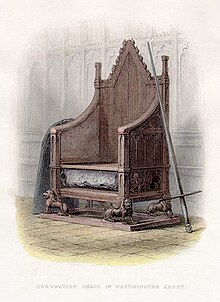Scone, Scotland

Scone (Modern Gaelic: Sgàin; Medieval: Scoine [skʊn]) is a town in Perth and Kinross, Scotland.
The medieval town of Scone, which grew up around the monastery and royal residence, ended in the early nineteenth century when Scone Palace was built on the site. The modern town of New Scone nowadays is simply called Scone. It has a population of over 4000 people and is a suburb of Perth.
Old Scone was the historic capital of (Scotland). In the Middle Ages it was an important royal centre, used as a royal residence and as the coronation site of the kingdom's monarchs. Around the royal site grew the town of Perth and the Abbey of Scone.
Scone and Scotland
[change | change source]
Scone's role came under threat as Scotland's twelfth century kings gradually became more French and less Gaelic. Walter of Coventry reported in the reign of William I of Scotland that "The modern kings of Scotland count themselves as Frenchmen, in race, manners, language and culture; they keep only Frenchmen in their household and following, and have reduced the Scots to utter servitude."[1] Though exaggerated, there was truth in this. Apparently for this reason, when the Normanized David I of Scotland (Dabíd mac Maíl Choluim) went to Scone to be crowned there in the summer of 1124, he initially refused to take part in the ceremonies.
Modern town
[change | change source]Constructing the new palace meant destroying the old town and moving its inhabitants to a new settlement. The new village was constructed in 1805 as planned town,[2] and originally called New Scone. It lies 2km to the west of the old location and 1½ km farther from Perth.[3] Until 1997 the town was called "New Scone", but is now referred to simply as Scone.[4] The town had 4,430 inhabitants according to the 2001 Census for Scotland, 84.33% of whom are Scottish; it is demographically old even compared with the rest of Scotland.[5]
The site of Old Scone is mostly in the grounds of the modern palace. This palace is a popular tourist attraction. Visitors come to see the gardens in the palace grounds, the exotic birds which roam freely in the grounds, Moot Hill, which lies in the grounds, as well as the palace itself.
Notes
[change | change source]- ↑ Memoriale Fratris Walteri de Coventria, ed. W. Stubbs, (Rolls Series, no. 58), ii. 206.
- ↑ Compared Evanton, constructed in 1807 by its landowner for similar motives.
- ↑ Compare geo.ed.ac.uk - Old Scone and geo.ed.ac.uk - New Scone Archived 2007-07-15 at the Wayback Machine.
- ↑ This is according to geo.ed.ac.uk Archived 2007-07-15 at the Wayback Machine.
- ↑ See 2001 Census, accessed Nov. 29, 2006 Archived 2015-04-02 at the Wayback Machine
References
[change | change source]- Barrow, G.W.S. (ed.), The Acts of Malcolm IV King of Scots 1153-1165, Together with Scottish Royal Acts Prior to 1153 not included in Sir Archibald Lawrie's '"Early Scottish Charters"', (Regesta Regum Scottorum vol. i, Edinburgh, 1960)
- Barrow, G.W.S., "The Removal of the Stone and Attempts at Recovery, to 1328", in Richard Welander, David J. Breeze and Thomas Owen Clancy (eds.), The Stone of Destiny: Artifact and Icon, (Edinburgh, 2003), p.
- Binchy, D.A., "Fair of Tailtiu and the Feast of Tara", in Ériu, vol. 18 (1958), pp. 113-38
- Broun, Dauvit, "Origins of the Stone of Scone as a National Icon", in Richard Welander, David J. Breeze and Thomas Owen Clancy (eds.), The Stone of Destiny: Artifact and Icon, (Edinburgh, 2003), pp. 183-97
- Clancy, Thomas Owen, "King-Making and Images of Kingship in Medieval Gaelic Literature", in Richard Welander, David J. Breeze and Thomas Owen Clancy (eds.), The Stone of Destiny: Artifact and Icon, (Edinburgh, 2003), pp. 85-105
- Cowan, Ian B. & Easson, David E., Medieval Religious Houses: Scotland With an Appendix on the Houses in the Isle of Man, Second Edition, (London, 1976), pp. 97-8
- Duncan, A.A.M., "Before Coronation: Making a King at Scone in the 13th century", in Richard Welander, David J. Breeze and Thomas Owen Clancy (eds.), The Stone of Destiny: Artifact and Icon, (Edinburgh, 2003), pp. 139-67
- Fawcett, Richard, "The Buildings of Scone Abbey", in Richard Welander, David J. Breeze and Thomas Owen Clancy (eds.), The Stone of Destiny: Artifact and Icon, (Edinburgh, 2003), pp. 169-80
- FitzPatrick, Elizabeth, "Leaca and Gaelic Inauguration Ritual in Medieval Ireland", in Richard Welander, David J. Breeze and Thomas Owen Clancy (eds.), The Stone of Destiny: Artifact and Icon, (Edinburgh, 2003), pp. 107-21
- Lawrie, Sir Archibald, Early Scottish Charters Prior to A.D. 1153, (Glasgow, 1905)
- McNeill, Peter G.B., and MacQueen, Hector L., (eds.), Atlas of Scottish History to 1707, (Edinburgh, 1996)
- O'Meara, John J. (ed.), Gerald of Wales: The History and Topography of Ireland, (London, 1951)
- Skene, William F. (ed.), Chronicles of the Picts, Chronicles of the Scots and Other Early Memorials of Scottish History, (Edinburgh, 1867)
- Skene, William F., "The Coronation Stone", in Proceedings of the Society of Antiquaries of Scotland, vol. 8 (1868-70), pp. 68-99
- Spearman, R.M., "The Medieval Townscape of Perth", in Michael Lynch, Michael Spearman & Geoffrey Stell (eds.), The Medieval Scottish Town, (Edinburgh, 1988), pp. 42-59
Other websites
[change | change source]- 2001 Census, accessed Nov. 29, 2006 Archived 2015-04-02 at the Wayback Machine
- geo.ed.ac.uk - Old Scone
- geo.ed.ac.uk - New Scone Archived 2007-07-15 at the Wayback Machine
